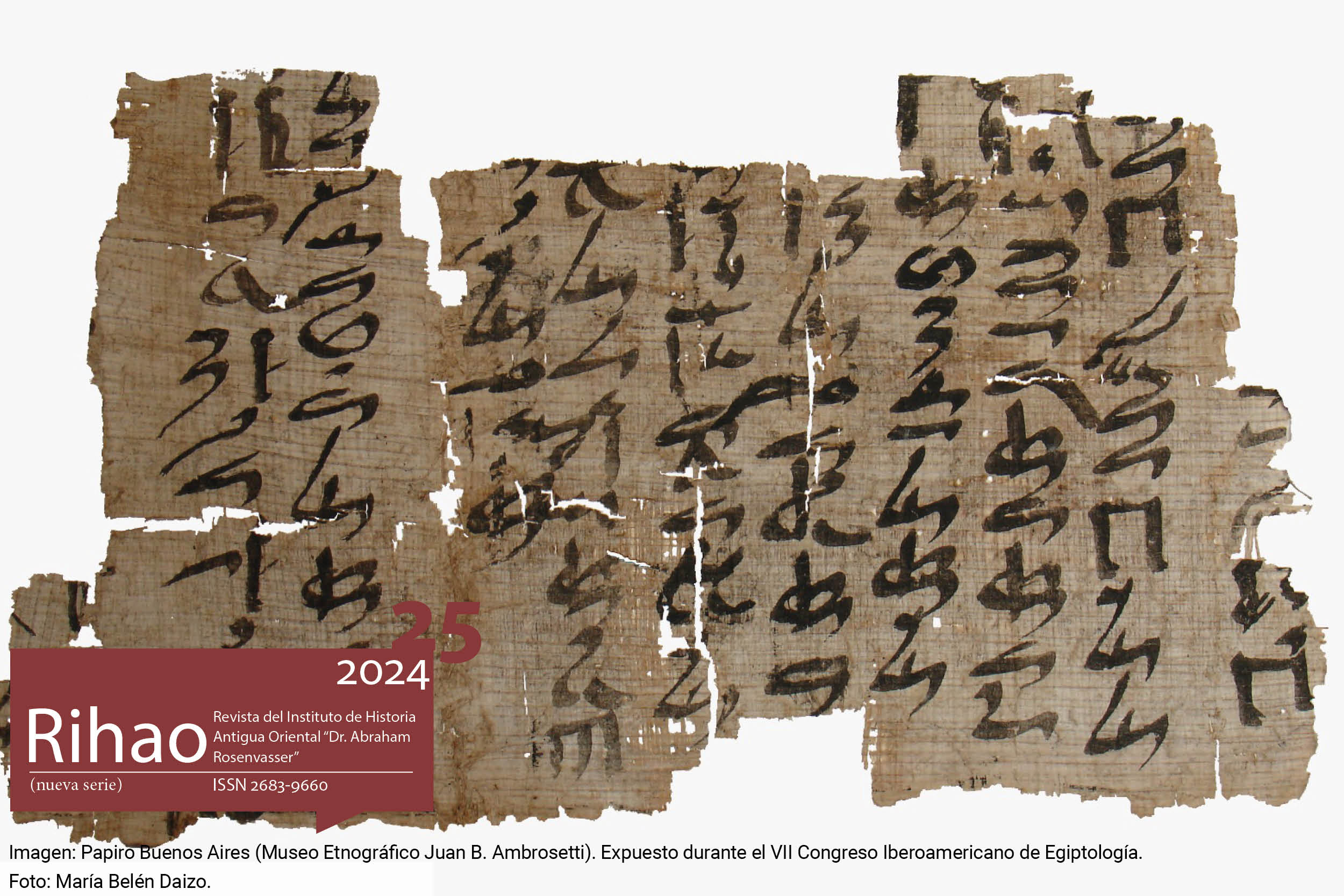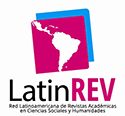La estatua de la tumba de Nakht (TT52): el hallazgo, el himno y las formas de Re
Resumen
La estatua de Nakht estaba ubicada en un nicho propio en la cámara interior de la tumba de un escriba y astrónomo del dios Amón, situada en el occidente de Tebas, actual Luxor. Esta estatua es uno de los objetos encontrados en la tumba y medía 40 cm de alto, con un hombre arrodillado sosteniendo una estela. Al categorizar este objeto, vemos que pertenece al tipo ste-lophor, el cual se basa en un contexto religioso que une los conceptos de estatua, estela y puerta falsa. En este artículo pretendemos analizar la estatua de Nakht desde la Teoría del Compromiso Material, propuesta por Lambros Malafouris, esclareciendo su posición en la tumba, su forma y el texto, para que podamos construir una idea de lo que el objeto podría simbolizar dentro de la creencia egipcia.Descargas
Citas
Assmann, J. (1971). Zwei Sonnenhymnen der späten XVIII. Dynastie in thebanischen Gräbern der Saitenzeit, in: Mitteilungen des Deutschen Archäologischen Instituts, Abteilung Kairo 27 (1): 1-33.
Assmann, J. (1983). Sonnenhymnen in thebanischen Gräbern. Mainz: Philipp von Zabern.
Assmann, J. (1995). Egyptian Solar Religion in the New Kingdom: Re, Amun and the Crisis of Polytheism. Londres: Kegan Paul International.
Assmann, J. (1999). Ägyptische Hymnen und Gebete. Übersetzt, kommentiert und eingeleitet. Friburgo / Gotinga: Universitätsverlag / Vandenhoeck & Ruprecht.
Assmann, J. (2003a). Mort e au-delà dans l’Égypte ancienne. Paris: Rocher.
Assmann, J. (2003b). The Ramesside Tomb and the Construction of Sacred Space, in: Strudwick, N. e Taylor, J. (eds.), The Theban Necropolis: Past, Present and Future. Londres: British Museum Press, 46-52.
Assmann, J. (2016). Egipto a la luz de una teoria pluralista de la cultura. Madrid: Akal.
Baines, J. (2007). Visual & Written Culture in Ancient Egypt. Oxford: Oxford University Press.
Barbotin, C. (2013). Un cas égyptien de texte constitutif de l’image: les statues stéléphores, in: Pallas 93: 53-66. En línea: https://journals.openedition.org/pallas/1338. [Consultado: 20-8-2023].
Barta, W. (1981). Der Dekankalender des Nutbildes und das Sothisdatum aus dem 7. Regierungsjahr Sesotris‘ III, in: Studien zur Altägyptischen Kultur 9: 85-103.
Bayoumi, A. (1940). Autour du champ de souchets et du champ des offrandes. Cairo: Imprimerie Nationale Boulac.
Canto Núñez, P. (2021). O espaço funerário no Egito Antigo: a tumba de Nakht (Reino Novo, c. 1401-1353 A.E.C.). Dissertação (Mestrado em História). Natal: Universidade Federal do Rio Grande do Norte.
Davies, N. (1915). The Egyptian Expedition 1914-15. I. The Work of the Robb De Peyster Tytus Memorial Fund, in: The Metropolitan Museum of Art Bulletin 10 (11): 228-236.
Davies, N. (1917). The tomb of Nakht at Thebes. Nova Iorque: The Metropolitan Museum of Art.
Erman, A. e Grapow, H. (1982). Wörterbuch der ägyptischen Sprache, vol. 4. Berlín: Akademie-Verlag.
Hays, H. (2004). Transformation of Context: The Field of Rushes in Old and Middle Kingdom Mortuary Literature, in: Bickel, S. y Mathieu, B. (eds.). D’un monde à l’autre. Textes des Pyramides et Textes des Sarcophagues. Cairo: Institut français d’archéologie orientale, 175-200.
Kampp, F. (1996). Die thebanische Nekropole: zum Wandel des Grabgedankens von der XVIII. bis zur XX. Dynastie. Mainz: Philipp von Zabern.
Laboury, D. (1997). Une relecture de la tombe de Nakht, in: Tefnin, R. (ed.), La peinture égyptienne ancienne: un monde de signes à préserver. Bruxelas: Fondation Égyptologique Reine Élisabeth.
Malafouris, L. (2013). How Things Shape the Mind: A Theory of Material Engagement. Cambridge: The MIT Press.
Malafouris, L. (2018). Mind and Material Engagement, in: Phenomenology and the Cognitive Sciences 18: 1-17.
Malek, J. (2011). Egyptian art. Londres: Phaidon.
Maspero, G. (1984). Le tombeau de Nakhti, in: Mémoires publiés par les membres de la Mission Archéologique Française au Caire 5 (3): 469-485.
Nyord, R. (2015). Cognitive linguistics (in Egyptology), in: Stauder-Porchet, J., Stauder, A. e Wendrich, W. (eds.), UCLA Encyclopedia of Egyptology. Los Angeles: UCLA, 1-11. En línea: https://escholarship.org/uc/item/9tf384bh. [Consultado: 20-8-2023].
Pereyra, M. V., Bonanno, M., Catania, M. S., Iamarino, M. L., Ojeda, V. C., Neira Cordero, E. S. e Lovecky, G. A. (2019). Neferhotep y su espacio funerario. Buenos Aires: IMHICIHU- CONICET.
Schäfer, H. (2002). Principles of Egyptian Art. Oxford: Clarendon Press.
Seidel, M. e Shedid, A. G. (1991). Das Grab des Nacht. Mainz: Philipp von Zabern.
Trigger, B. (2004). História do pensamento arqueológico. São Paulo: Odysseus.
Seyfried, K. J. (1995). Generationeninbindung, in: Assmann, J., Dziobek, E., Guksch, H. e Kampp, F. (eds.), Thebanische Beamtennekropolen. Heidelberg: Heidelberger Orientverlag, 228-229.
Stewart, H. M. (1967). Traditional Sun Hymns of the New Kingdom, in: Bulletin of the Institute of Archaeology, University of London 6: 29-74.
Wilkinson, R. (1992). Reading Egyptian Art. Londres: Thames & Hudson.
Wilkinson, R. (2003). Magia y símbolo en el arte egipcio. Madrid: Alianza.
Derechos de autor 2024 Pedro Hugo Canto Núñez

Esta obra está bajo licencia internacional Creative Commons Reconocimiento-NoComercial 4.0.





.jpg)







